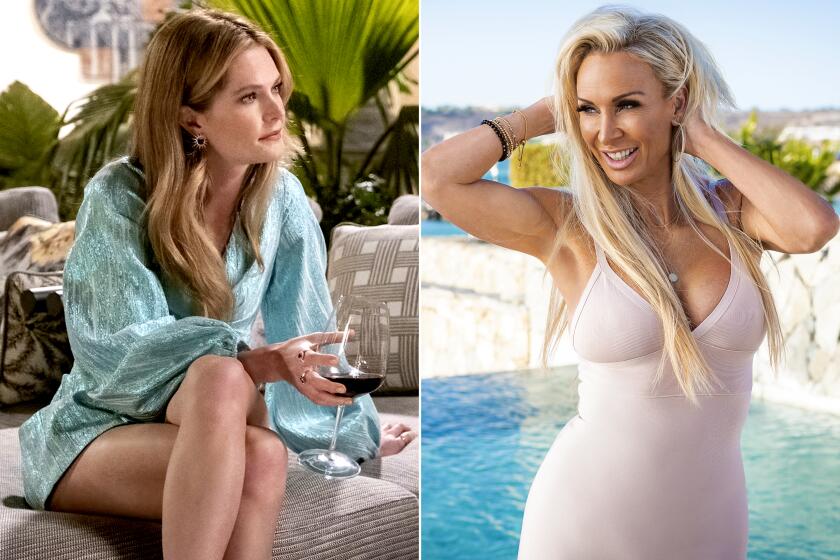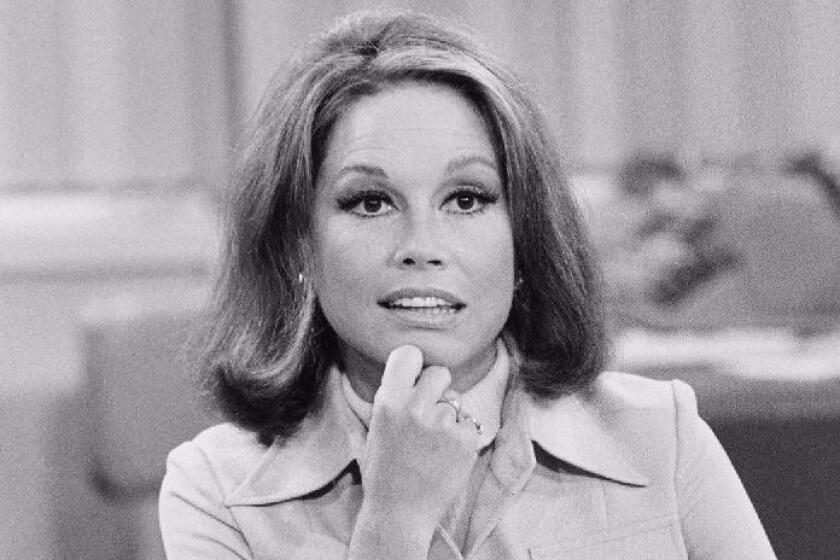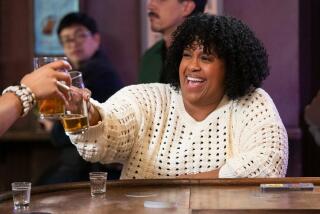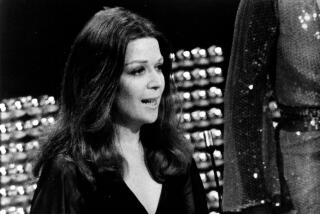With her widower’s help, a splendid new documentary explores Mary Tyler Moore’s private side
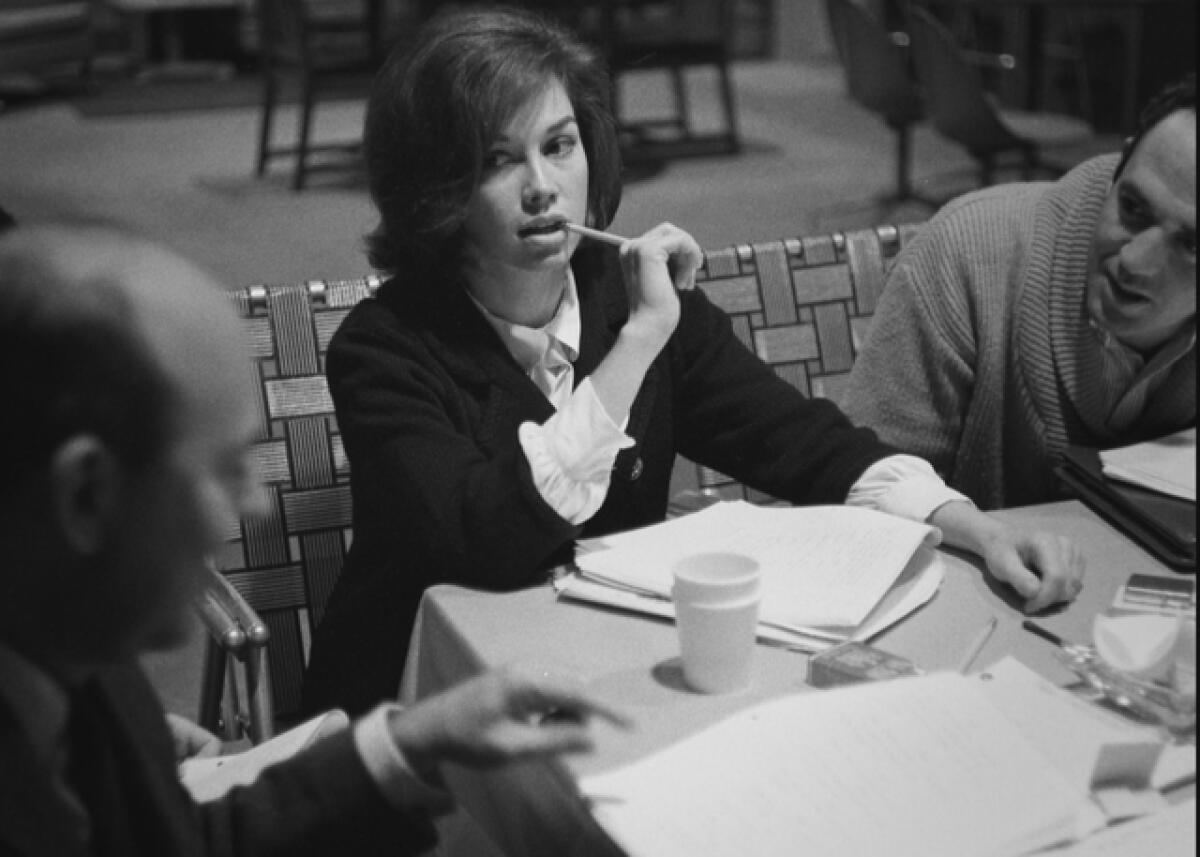
“Who can turn the world on with her smile?” It’s Mary Tyler Moore, of course, and you should know it.
To be precise, it’s Mary Richards, a person Moore played. But the smile was her own, and it worked magic across two situation comedies that described their time in a way that some might have regarded as ahead of their time. Although Moore proved herself as an actress of depth and range and peerless comic timing again and again, on the small and big screen and onstage, “The Dick Van Dyke Show” and “The Mary Tyler Moore Show” made her a star, and incidentally a cultural figurehead, and are the reason we have a splendid new documentary, “Being Mary Tyler Moore,” premiering Friday on HBO. Were it titled simply “Being Mary,” there’d be little doubt who was meant.
Moore was driven to perform from an early age, which she relates to wanting to impress her father — though that seems too simple. She trained as a dancer, and right out of high school played a pixie, Happy Hotpoint, in a series of appliance commercials. (A visible pregnancy ended that job.) She played a faceless switchboard operator on “Richard Diamond, Private Detective,” from which she was bounced when she asked for more money, and a typical assortment of starlet roles in television and movies. A failed audition to play the older daughter on “The Danny Thomas Show” led to her being called for “Van Dyke,” of which Thomas was an executive producer. Creator Carl Reiner remembers, “I read about 60 girls, and I read the whole script with them. She read three lines, three simple lines. There was such a ping in it, an excitement, a reality to it.” They soon discovered her gift for comedy.
“The Dick Van Dyke Show,” in which Moore played Laura Petrie to Van Dyke’s Rob, came into the world in the first year of the Kennedy administration, and there is something of that new White House, torch-passed-to-a-new-generation spirit in the Petries’ New Rochelle, N.Y., home. (Van Dyke was 35 when the show premiered — just old enough to be president himself — to Moore’s 24, but the two never seemed generationally distinct.) They were modern, with modern tastes. This was not the old-fashioned, small-town family comedy of “Father Knows Best” or “Leave It to Beaver.” If you lived in my household, you might have felt right at home with them.
By turning HBO Max into just Max and jamming it with Discovery+ content, the company is spitting on one of the most important brands in television.
Then again, “Dick Van Dyke” was not really a family comedy; some episodes might involve their son, Richie (Larry Mathews), but many more would not, and when child-rearing was the subject, it would more likely highlight the foolishness of the parents. The Petries were suburban in the sense of being connected to, not remote from, the city — sophisticated, fun, elegant. They threw parties, went out in formal wear, tried the latest dances. They were sexual. And they held the stage with equal strength and force.
If they were well on the safe side of bohemian, they were arty in their way, Rob a comedy writer, Laura, like Moore, a dancer — a former dancer in the show, which was not so ahead of its time to imagine a working mother. Still, the series found opportunities to let her dance. (“I will go to my grave thinking of myself as a failed dancer, not a successful actor,” Moore says in the documentary.)
Famously — and at once realistically and, for TV at that time, radically — she wore pants, tight ones; Moore is nearly synonymous with Capris. I turned on a random episode the other night (Season 4, Episode 1, “My Mother Can Beat Up My Father”), one I’d somehow never seen, in which a drunk at a restaurant bar begins to harass Laura. Rob tries to get him to back off, claiming he knows karate, and gets a punch in the nose — at which Laura, to her own surprise, flips the drunk with a judo move. (She’d learned self-defense when she was entertaining at Army bases.)
It winds up in a society column. Laura finds it funny. Rob, whose ego is as bruised as his proboscis, childishly lashes out.
Rob: “How come you never dress like a girl?”
Laura, incredulous: “What?
“Well, honey, I mean, shirts and slacks, shirts and slacks, that’s all I ever see when I come home.”
“You love me in shirts and slacks.”
“Yeah, well, but whatever happened to dresses?”
“Rob, you know, this is the stupidest conversation we’ve ever had.”
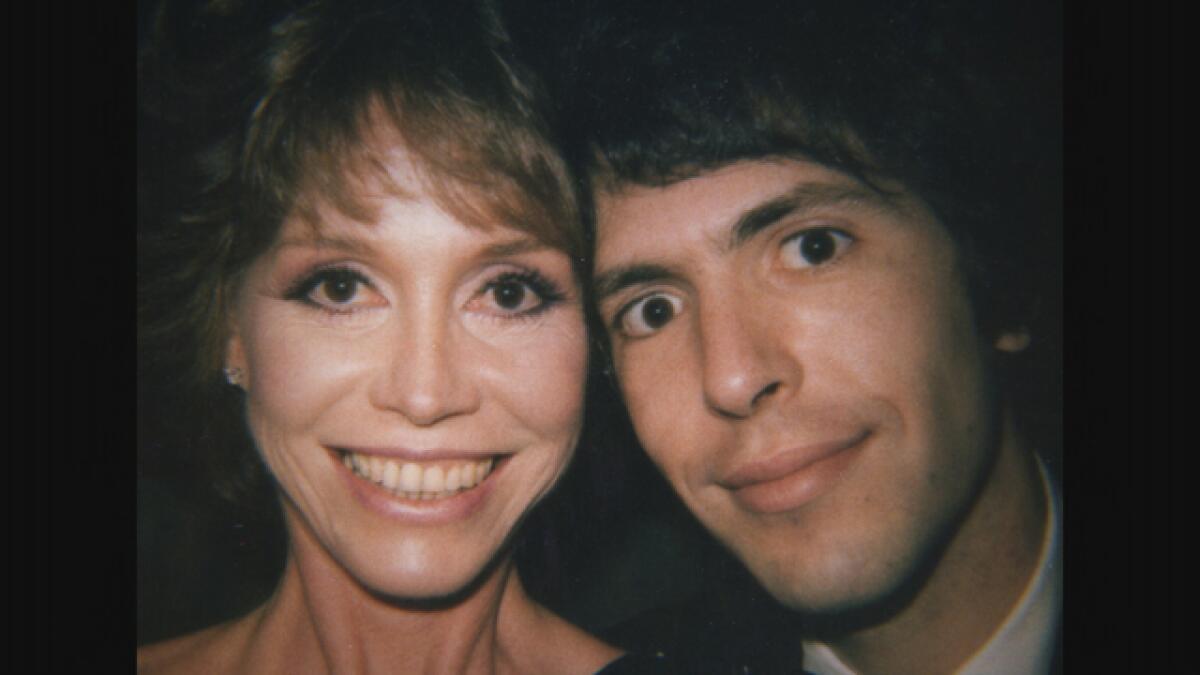
“Dick Van Dyke” stories were divided equally between home and work, with the two worlds frequently intersecting. “The Mary Tyler Moore Show” took that model and put Moore in the center of the action, amid a brilliant comic cast. Her move to Minneapolis, which begins the series and lands her in the newsroom at WJM, was not born from tragedy or pressure; she moves on her own initiative, recovering from nothing but the possibility of a life that won’t suit her.
That Mary was a single woman in no rush to be married was something new for television — but it could hardly be said that she lived alone; her apartment was subject to regular incursions from Rhoda (Valerie Harper) and Phyllis (Cloris Leachman), a company of women hashing out their different lives in a sort of dialectical comedy. (There were women in the writing room; Treva Silverman, whose comments are featured prominently in “Being Mary Tyler Moore,” was the first woman to win an Emmy with a solo credit.)
Whether this was or was not a feminist series is a question that still prompts think pieces. Gloria Steinem thought not, and Moore did not identify herself as such — though in the opening scene of the documentary, in a 1966 interview with a backward David Susskind, she does say, “I agree with Betty Friedan and her point of view in her book ‘Feminine Mystique’ that women are, or should be, human beings first, women second, wives and mothers third.”
For the record:
4:36 p.m. May 26, 2023The co-creator of “The Mary Tyler Moore Show” is James L. Brooks. He was misidentified as James Burrows in an earlier version of this story.
Unlike the Norman Lear comedies — “All in the Family,” also on CBS, premiered a few months after “The Mary Tyler Moore Show” — the MTM-produced comedies, which also included the “Moore” spinoffs “Rhoda” and “Phyllis,” were contemporary and “adult” without being issue-oriented. But because they were realistic about their characters, they couldn’t help but engage with their times and the culture. If the feminism of “Mary Tyler Moore,” which is in a sense just a function of its intelligence, is not explicit, it is in the bones of the show. And Mary, like the woman who played her, “inspired as many women as Eleanor Roosevelt,” in the words of series co-creator James L. Brooks.
If Moore never repeated the massive television success of her first two series, well, that would have been practically impossible. Some failed later shows, including the sitcom “Mary,” which found her working at a Chicago tabloid, and “The Mary Tyler Moore Hour,” which blended variety with a backstage sitcom, go unmentioned in the documentary, but are not without interest and may be found floating in cyberspace. Various dramatic roles, onscreen and onstage, demonstrated the subtlety and depth of her acting, though you could find that in most any episode of “Mary Tyler Moore” as well.
Mary Tyler Moore, who died Wednesday at age 80, was the second great woman of television.
Her last great triumph — though not at all the end of her career — was her Oscar-nominated turn in Robert Redford’s “Ordinary People,” whose cold mother is deemed closer to her own character; she had a reputation, she says, for being “an ice princess.” Redford decided to cast her having once seen her walking on the beach, looking sad. (“He saw my dark side.”)
It is the point of nearly any show business biography that the person we know from their work is and is not the person who lived the life. Indeed, the very title “Being Mary Tyler Moore” suggests that “Mary Tyler Moore” was both a part she played and a person she was, similar in some respects and markedly different in others. Directed by James Adolphus, with Moore’s widower, Dr. Robert Levine, on board as an executive producer, the film has access to a wealth of family photos and home movies — including footage of her bridal shower, featuring a hilarious Betty White — and does a fine job of illuminating the private Moore, with testimony from (unseen) colleagues, friends and family.
It’s no secret that her life was marked by tragedy. (She was a private person, but she wrote books. And some things you can’t keep out of the papers.) She had a drinking problem. Her sister died from an overdose of alcohol and painkillers. Her son, Richard, accidentally shot himself. Diabetes led to numerous problems with her health. But “Being Mary Tyler Moore” is a happier story than one might expect, which in itself makes it a moving one. Moore and Levine were married from 1983 to her death in 2017, and they settled into a life filled with dogs and horses; there were good works too, on behalf of juvenile diabetes.
We can too easily measure the worth of a performer’s life by their professional success, as if there’s nothing more terrible than a canceled sitcom, a box office flop or the lack of good roles all but a few actors eventually face. “Being Mary Tyler Moore” reminds us not to make that mistake.
‘Being Mary Tyler Moore’
When: 8 p.m. Friday
Where: HBO
Streaming: Max
Rating: TV-PG (may be unsuitable for young children)
__________
More to Read
The complete guide to home viewing
Get Screen Gab for everything about the TV shows and streaming movies everyone’s talking about.
You may occasionally receive promotional content from the Los Angeles Times.
